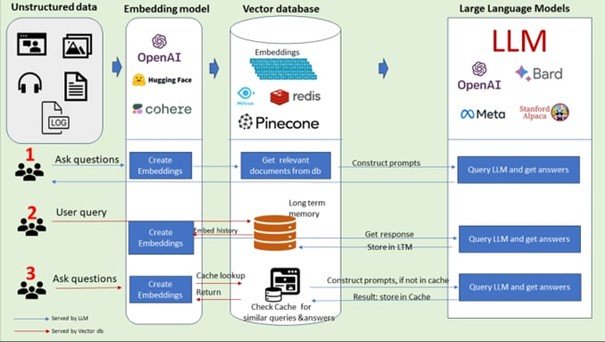LLM and Vector Databases
Importance of LLM and Vector Databases Combination: An Overwiev
November 23, 2023
Gizem Argunşah

LLMs and Vector Databases: An Overview
Large Language Models (LLMs) are artificial intelligence systems that can generate natural language texts based on a given input, such as a prompt, a query, or a context. LLMs are trained on massive amounts of text data, such as books, articles, web pages, social media posts, and more, to learn the patterns and structures of natural language. LLMs can perform various tasks, such as text summarization, translation, question answering, text generation, and more, depending on the input and the objective1.
Vector databases are a type of database that can store and query high-dimensional vectors, such as word embeddings, image features, or audio fingerprints. Vector databases can enable fast and accurate similarity search, which is useful for applications such as recommendation systems, image retrieval, face recognition, natural language processing, and more2.
LLMs and vector databases can be used together to create powerful and scalable applications that leverage the capabilities of both technologies. For example, one can use a vector database to store the embeddings of a large corpus of text, such as Wikipedia articles, and then use an LLM to generate relevant and coherent summaries or answers based on a user query. Alternatively, one can use an LLM to generate natural language descriptions or captions for images or videos, and then use a vector database to index and retrieve them based on semantic similarity.
Some examples of LLMs and vector databases are:
GPT-4
A state-of-the-art LLM developed by OpenAI, which can generate coherent and diverse texts on various topics and domains. GPT-4 is trained on over 500 billion tokens of text data, and has 175 billion parameters, making it one of the largest LLMs in the world.
Claude 2
A novel LLM developed by Anthropic, which can generate texts that are not only fluent and informative, but also ethical and aligned with human values. Claude 2 is trained on a curated subset of the Common Crawl dataset, and uses a reinforcement learning framework to optimize for human feedback.
Llama
A meta-learning LLM developed by Meta, which can adapt to new tasks and domains with few examples. Llama can perform tasks such as text classification, sentiment analysis, named entity recognition, and more, by learning from a small set of labeled data and a large unlabeled corpus.
Vector
A vector database developed by Vector AI, which can store and query billions of vectors with sub-second latency and high accuracy. Vector supports various vector operations, such as nearest neighbor search, clustering, filtering, aggregation, and more. Vector also provides a user-friendly interface and a rich set of APIs for developers.
Milvus
An open-source vector database developed by Zilliz, which can handle massive-scale vector data and enable flexible and reliable vector similarity search. Milvus supports various vector index types, such as IVF, HNSW, NSG, and more, and integrates with various machine learning frameworks, such as TensorFlow, PyTorch, Scikit-learn, and more.
Pinecone
A cloud-based vector database service developed by Pinecone, which can scale up and down to meet the needs of various applications. Pinecone provides a simple and intuitive interface and a powerful query engine for vector similarity search. Pinecone also offers features such as deduplication, ranking, filtering, and more.
LLMs and vector databases are two emerging technologies that can enable new and exciting applications in various domains and industries. By combining the natural language generation capabilities of LLMs and the vector similarity search capabilities of vector databases, one can create applications that can provide relevant and personalized information, insights, and recommendations to users.
To try free demo, please click here!
